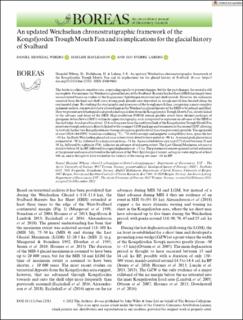| dc.description.abstract | The Arctic is a climate-sensitive area, responding rapidly to present changes, but for the past changes, the record is still incomplete. For instance, the Weichselian glacial history of the Svalbard–Barents Sea Ice Sheet (SBIS) has largely been reconstructed based on studies of the fragmentary Spitsbergen terrestrial and shelf records. However, the sediments removed from the land and shelf areas during peak glacials were deposited on trough mouth fans located along the continental slope. By studying the stratigraphy and processes of the trough mouth fans, comprising a more complete sediment archive, our new data have allowed gaps in the Weichselian glacial history of the SBIS to be refined and filled. Here we present new lithological and geochronological data from the Kongsfjorden Trough Mouth Fan, closely linked to the advance and decay of the SBIS. High-resolution TOPAS seismic profiles reveal three distinct packages of glacigenic debris flows (GDFs) within its upper stratigraphy, each interpreted to represent an advance of the SBIS to the shelf edge. A radiocarbon dated, 12.6-m-long core from the southern flank of the Kongsfjorden Trough Mouth Fan penetrates trough sediments directly linked to the youngest GDF package and terminates in the second GDF, allowing us to study the last two Kongsfjorden ice-stream advances in greater detail than was previously possible. The age model of core GS10-164-09PC, based on combining 14C-, 18O-stable isotope and magnetic susceptibility data, spans the last ~54 ka. An Early Weichselian glacial advance is tentatively dated to have ended at ~90 ka. A second peak glaciation is estimated at ~70 ka, followed by a deglaciation from ~54 ka. An ice rafted debris-rich unit (U7) dated between 38 and 34 ka, followed by a plumite (U6), indicates an advance of unknown extent. The Last Glacial Maximum advance is dated to before 24 ka BP, followed by a rapid deglaciation at ~15 ka. The presence of coarser-grained sorted sediments at the present seafloor is attributed to the influence of the West-Spitsbergen Current, acting on water depths of at least 846 m, and is thought to have worked in the vicinity of the coring site since ~14 ka BP. | en_US |

